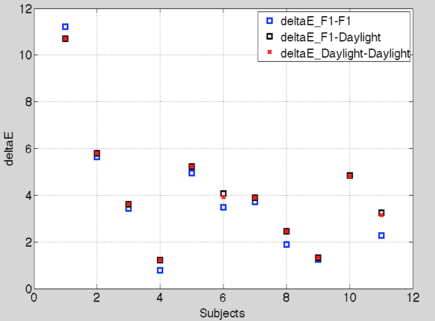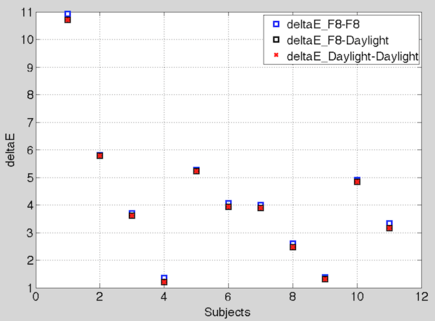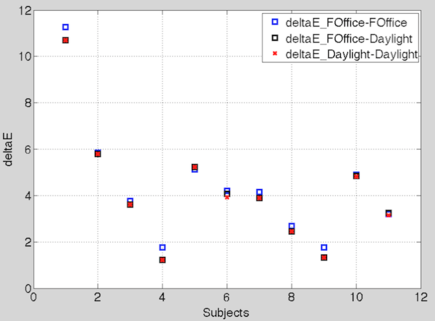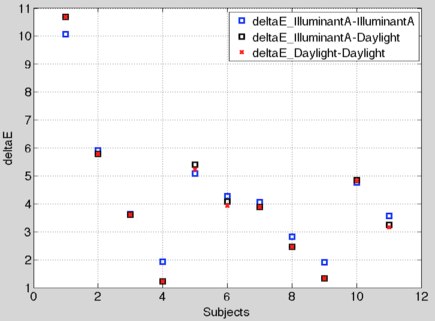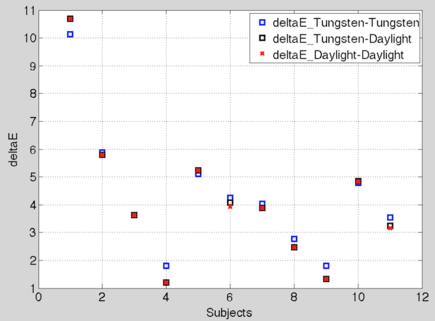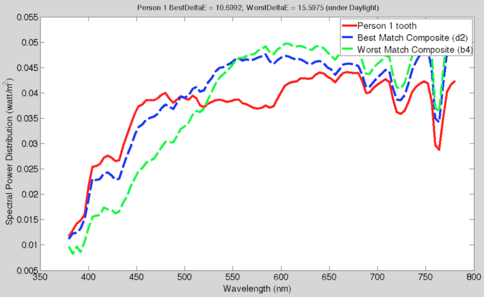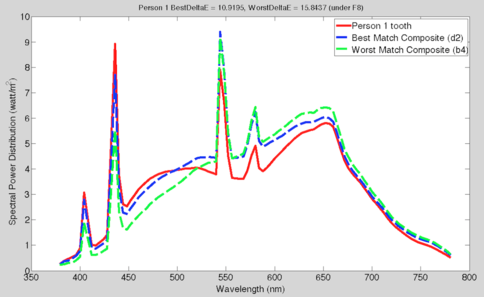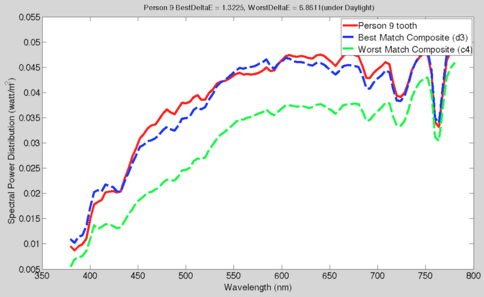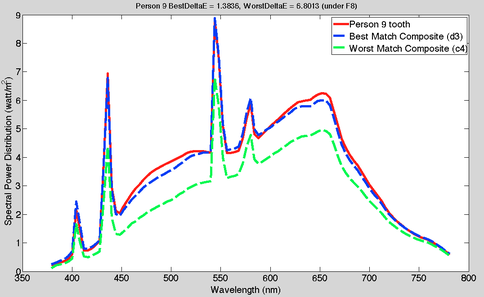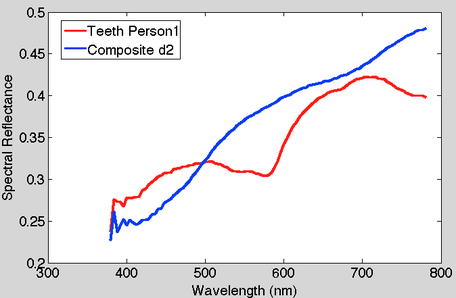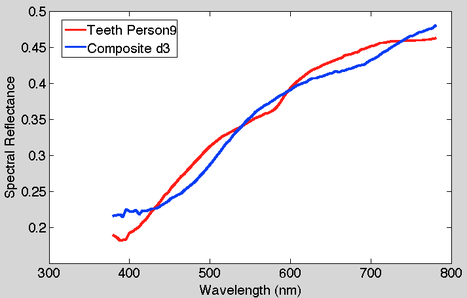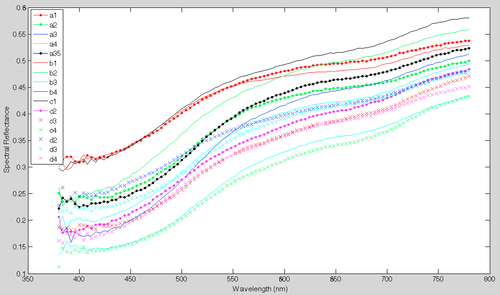Color Matching in Dentistry
Nehal Bhandari, Krithi KN
Introduction

Dentists use composites to fill cavities in teeth, and use porcelain implants to replace teeth. These composites and porcelain fillings are available in several shades, and the dentist has to select the shade that best matches the color of the tooth being replaced or filled. Dentists rely on their visual judgment to make this color matching, and this is done under the lighting conditions of their office. We have learnt in PSYCH 221 that two materials that appear to have same color under a given light, may not match when observed under a different light. So the composite chosen by the dentist may not match the color of the tooth when observed under daylight.
Motivation
The first thing we notice about a person when we meet them is his/her smile. So we believe it is very important to avoid imperfections in tooth fillings/implants. Our goal is to study the characteristics of the reflectance of teeth and composite materials under different artificial illuminants, and compare them to that under daylight. Through this study, we quantify the mismatches between the composite and the color of the tooth when the composite is chosen under an artificial light but observed under daylight. We conduct this study across several people and several lights, to arrive at conclusions on what factors influence finding of a good composite match for a person.
Methodology
This project has three components:
- Measure the reflectance of teeth in-situ in different individuals and the reflectance of different composite and porcelain materials through spectroradiometric measurements.
- Second, we use this data and the CIELAB color difference metric to predict whether people will be able to detect the difference between teeth and composite material under different lighting conditions.
- Third, we analyze the processed data to determine what factors play significant role in getting good matches for different individuals.
Data Collection

Using a spectrographic camera, we measured the spectral power distribution of the following:
- The reflectance of teeth of eleven different people,
- The reflectance of sixteen different shades of composite materials (A1 to A4, B1 to B4, C1 to C4, and D2 to D4),
- The light that falls on teeth during each measurement. (Represents the white point under the lighting conditions)
Data Analysis
For each individual, we calculate the CIELAB color difference (delta-E) between his teeth and the different composites available, under daylight and various artificial illuminants, using ISET functions. We then find the best-match composite, i.e. the composite that gives the least delta-E when compared against his teeth. We then repeated this process for all people. So we now know which composites would give the best match for every individual under a given light.
Consider the following notation: . For all further discussion this notation means deltaE computed between person X's teeth and composite Y when observed under Illuminant B such that, Y is best match for X under Illuminant A. So for example, is deltaE for a composite which is best match in F1 but is being observed under daylight.
Now we know that the dentist performs color matching under an artificial illuminant. We want to quantify the mismatch when this composite chosen under an artificial light is viewed under daylight. To be able to do this analysis, we calculate the following delta-E values under each illuminant L for all subjects:
- : Delta-E of the composite picked under L, when viewed under L.
- : Delta-E of the composite picked under illuminant L, when viewed under daylight.
- : Delta-E of the composite picked under daylight, when viewed under daylight. Here, the composite may be different from that chosen under L and we will always have
Another interesting question would be, when a composite that is chosen such that it matches the best under daylight, how off will the teeth and composite look, when viewed under other interior light L. To answer this, we calculated the following deltaE value:
- : Delta-E of the composite picked under daylight, when viewed under illuminant L.
- : Delta-E of the composite picked under daylight, when viewed under daylight.
Results
Next we demonstrate some results from our data analysis.
DeltaE Comparisons for matches in Artificial Lights
Figure 1 shows values for 6 different illuminants L. The original analysis was done over 16 different illuminants, but due to limited space, we show results for 6 most interesting cases. We make the following different observations from Figure 1:
- For most subjects, the best match composite under a given illuminant is same as best match composite under daylight. This is seen as . Infact, Fluorescent 8 agrees with daylight on the best composite for all 11 people. The variation in deltaE values for a given subject across different illuminants is also not very significant. The best picked match may sometimes look worse off in daylight (Ex: Figure 1 a)) , or it may look even a better match in daylight (Ex: Figure 1 )). But these changes in appearance will be minor and cannot convert a very good match in one light to a poor match in another light and vice versa.
- The most interesting observation is that there is huge variation in deltaE values across subjects, for any given illuminant. There are some subjects (Person 1, 2, 5, and 10) for whom you cannot find a good match (deltaE >> 1) in any given light. This goes to show that more than the light under which we make a match, the limited composite set affects the finding of a good match for a person. On the other hand, there are some subjects (Person 4 and 9) for whom we could find a good match (deltaE close to 1) within the studied composite materials, for any given illuminant.
- Figure 1: DeltaE variation across subjects under various illuminants
-
- a) Fluorescent 1
-
- b) Fluorescent 8
-
- c) Fluorescent 11
-
- d) Fluorescent Office
-
- e) Illuminant A
-
- f) Tungsten
Effect of Teeth & Composite Sectral Power Distributions
In order to get an insight on the second observation of Figure 1, we zoom into 2 subjects - Person 1 (who doesn't have a good match under any illuminant) and Person 9 (who has a good match under all illuminants). For each of these subjects, we plot SPD of best and worst match composite under daylight and one of the artificial lights- Fluorescent 8 in Figure 2. The figure basically depicts the spectral power of the light reaching the eye from the tooth and the spectral power of the light reaching the eye from the composite. When the two signals are similar (different), we can expect a small (large) deltaE value. Some of the key observations are:
- Figure2 c) and d) show that in case of low deltaE values, the spectral power of the light reaching the eye from the best match composite very closely follows the spectral power of the light reaching the eye from the person's teeth under both Daylight and Fluorescent8. While the deltaE values for same person and composite pair, differ slightly under different illuminants, we notice that this change is not very significant. What seems to be the more important factor here is how similar the spectral reflectances of the composite material and subject's teeth are (without the effect of any illuminant). This reasoning is further supported by Figure 3, which we discuss later.
- Figure2 a) and b) show that when we do cannot find a good match for a person amongst the limited set of composites, even the best match composite has spectral power quite different from that of the subject's teeth (and hence the large deltaE values). Again variations across illuminants is not significant. This can be justified by saying the spectral reflectance of the composite materials and spectral reflectance of subject's teeth are very different.
- Figure 2: Best & Worst Match Composites
-
- a) Person1 in Daylight: BestDeltaE=10.6992 WorstDeltaE=15.5975
-
- ) Person1 in Fluorescent 8: BestDeltaE=10.9195 WorstDeltaE=15.8437
-
- a) Person9 in Daylight: BestDeltaE=1.3225 WorstDeltaE=6.8611
-
- b) Person9 in Fluorescent 8: BestDeltaE=1.3836 WorstDeltaE=6.8013
Spectral Reflectance for Teeth and Composite
We concluded from the previous figure that though since effect of illuminant is not significant, it could be the spectral reflectances of the teeth and composite materials, which determines whether a good match can be found or not. Figure 3 explains this observation, which shows the spectral reflectance for Person1 and Person9 along with spectral reflectances of composite materials which were found to be best match for these subjects by majority of the illuminants.
- Figure 3: Spectral Reflectance
-
- a) Person1, Composite D2
-
- b) Person9, Composite D3
We can see here that the spectral reflectances of Person1 and Composite D2 are very different, even though it is the best match composite. On the other hand Person9 and Composite D3 have very close spectral reflectance values for all wavelengths. Thus we observe a very good match in this case.
- Figure 4: Spectral Reflectance for all Subjects and Composites
-
- a) Spectral Reflectances for teeth of various subjects
-
- b) Spectral Reflectances for various composites
Now let's have a look at the big picture. From Figure1, we know that no good matches were found for Person 1, 2, 5 and 10. The dotted curves in Figure 4 a) show spectral reflectances for these subjects. We see that these curves are quite different from composite curves either in shape or in magnitude (very bright teeth). This results in no good match for these people.
DeltaE Comparisons for matches in Artificial Lights
So far, we have been looking at the scenario where we pick the best composite in some artificial interior light and determine how good the match would appear in daylight. Some important questions to answer are : While daylight matching is important, is it sufficient to get a good match in daylight? How will a good match in daylight appear, when viewed in some indoor light? We try to answer these questions using Figure 5, which plot and , i.e, best composite picked in daylight and viewed in all lights.
- Figure 5: DeltaE variation across subjects under various illuminants
-
Some observations from Figure5 are:
- The blue curve indicates values of . These tend to be the minimum for most of the subjects, since match is being made in daylight. However, under some illuminants, a match made under daylight might look even better than in daylight itself. For example for Person 4 and 9, if the match was made in daylight, it would look better in F4, F5 and F6 and worse in other lighting conditions.
- While the values of deltaE are different, the total variation in deltaE values for any subject across all studied lights is not as significant so as to convert a good match in daylight to a very bad match in some other light or vice versa.
Conclusions
- We find that there are some subjects for whom the matches were not so great under any light (deltaE >> 1 ). This seems to suggest that we need to expand the set of composite materials being studied in order to hope for better matches for such subjects. Just varying illuminant in a limited set on composites, is not enough to convert a bad match to a good match.
- The spectral reflectance of composites and teeth were very similar for a good match and very different for a bad match. So the reason why the same composite gave similar DeltaE under different lights can be explained by the similarity in spectral reflectances. In other words, if the spectral reflectances are the similar, they will be a good match under any light. If the spectral reflectances of teeth and composite are very different, they will be a poor match under any light.
All these conclusions are however, subject to the accuracy of the measurements. So it is important to repeat these experiments with more lights, subjects and composites in order to validate these conclusions.
References
- Ng, DuYong, et al. "Non-contact imaging colorimeter for human tooth color assessment using a digital camera." Journal of Imaging Science and Technology 47.6 (2003): 531-542[1]
- CIE Fluorescent series: http://www.cis.rit.edu/research/mcsl2/online/cie.php
Appendix I
Appendix II
The experimental readings for spectrophotometric data were taken together in the lab. Both team members worked together on data processing and evaluation. There is no easy way to demarcate the contributions from each team member. Both have gained equally from this project.










